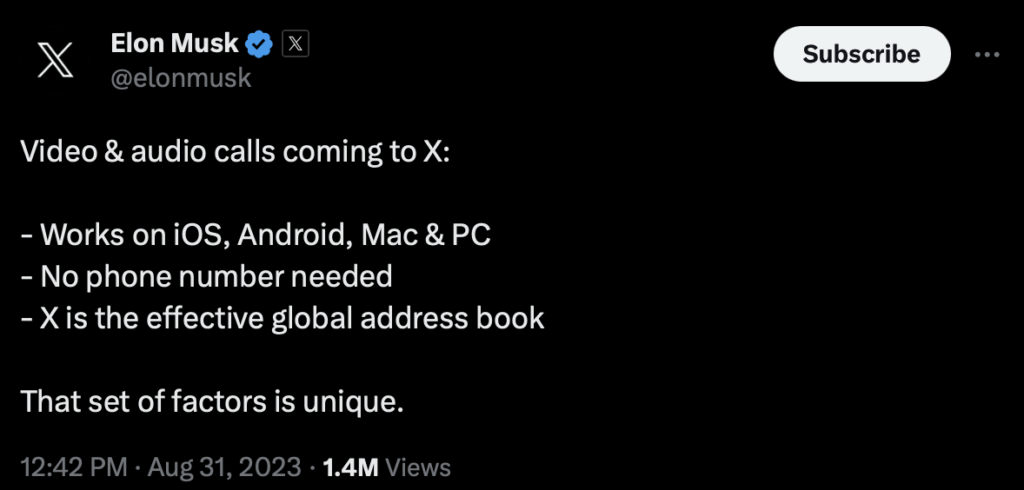In a bold move set to revolutionize the way we interact on social media, Elon Musk has announced its plan to launch video and audio calls for 541 million users of X.com (earlier Twitter). The feature is expected to roll out soon, allowing millions of users of X.com to connect in new and innovative ways without sharing their mobile numbers.
The move comes as X.com (Twitter) continues to diversify its platform and cater to the evolving needs of its user base. With the rise of video conferencing and the increasing demand for seamless communication, this introduction couldn’t be timelier.
In a fresh tweet, Elon Musk disclosed that the audio/video calling feature would be available for iOS, Android, Mac and PCs.

Why Video and Audio Calls on X?
Introducing video and audio calls aligns with X’s commitment to fostering real-time and meaningful conversations. By integrating these features, Twitter aims to keep users engaged within its platform, eliminating the need to switch to third-party apps or services for voice and video communication.
This addition also addresses privacy concerns. Unlike traditional phone calls, where you typically have to share your mobile number, Twitter’s new feature will allow you to make calls directly from the app or desktop, preserving your privacy while staying connected.
Seamless Integration
One of the standout features of Twitter’s upcoming update is its seamless integration. Users will be able to initiate video or audio calls directly from their DMs (Direct Messages) or from a chat group, making it incredibly convenient for both personal and professional communication.
The video call function will be especially valuable for users looking to host virtual meetings, interviews, or catch-up sessions with friends and family. Twitter’s move into this space could also give competition to dedicated video conferencing platforms like Zoom and Google Meet.
No Mobile Number Sharing
Perhaps one of the most appealing aspects of Twitter’s video and audio call feature is that it won’t require you to share your mobile number with other users. Instead, the calls will be made through the Twitter app or desktop version, ensuring your contact information remains private.
This added layer of security is bound to attract users who are cautious about sharing personal details online. It’s a step towards making the platform safer and more user-friendly.
How Will it Work?
While Twitter has not yet released the full details of this feature, it is expected to be user-friendly and intuitive. To make a call, users may simply click on a contact’s profile, where an option to initiate a video or audio call will be available. From there, a request can be sent, and upon acceptance, the call will commence.
The feature is likely to support one-on-one calls as well as group calls, making it versatile for both personal and professional use. It’s expected to integrate seamlessly with Twitter’s existing messaging system.
The Potential Impact
The introduction of video and audio calls on Twitter has the potential to reshape the way we use the platform. It could make Twitter not just a place to share thoughts and ideas in text, but also a hub for real-time, face-to-face communication. Whether you’re a business professional looking to hold virtual meetings or want to connect with friends and family in a more personal way, this feature promises to be a game-changer.
Additionally, it could enhance Twitter’s competitive edge in the social media landscape. While platforms like Facebook and Instagram have introduced their own messaging and calling features, Twitter’s focus on privacy and user engagement could set it apart.
A Clash of Titans in Messaging
Twitter’s move to introduce video and audio calls to its platform is undoubtedly a strategic decision that places it in direct competition with WhatsApp, one of the world’s most popular messaging apps. This development has the potential to redefine how users communicate and interact on social media.
But, is it poised to make a dent in WhatsApp’s usage behaviour?
Twitter’s emphasis on privacy and security is evident in its decision to allow users to make calls without disclosing their mobile numbers. This approach aligns with users’ growing concerns about data privacy, and it’s a significant advantage over WhatsApp, which typically requires users to share their phone numbers.
WhatsApp, on the other hand, is known for its end-to-end encryption, providing a high level of security. However, Twitter’s focus on keeping conversations within its platform might appeal to users looking for an extra layer of privacy.
Another advantage users would enjoy is the seamless integration of Audio/Video calling feature. Twitter’s integration of video and audio calls directly into its platform could be seen as a convenience feature. Users won’t have to switch between apps for different types of communication. This could particularly benefit businesses and content creators who rely on Twitter for engagement and now have a more robust toolset at their disposal.
On the flip side, Twitter does not have the same scale in messaging as WhatsApp. Users typically go to Twitter for public discussions, news updates, and to follow their favorite figures. It might take time for users to adapt to the idea of using Twitter for audio or video conversation.
Conclusion
Twitter’s competition extends beyond WhatsApp, as it competes for user attention with various social media platforms. Its success in the messaging space will depend on its ability to provide a compelling alternative to existing messaging apps.
Twitter’s decision to introduce video and audio calls is an exciting development that could redefine how we connect and communicate on social media. With a focus on user privacy, seamless integration, and real-time conversations, this feature is set to make Twitter an even more essential platform for personal and professional networking. Keep an eye out for updates, as this game-changing addition is expected to roll out soon, ushering in a new era of social media interaction.

